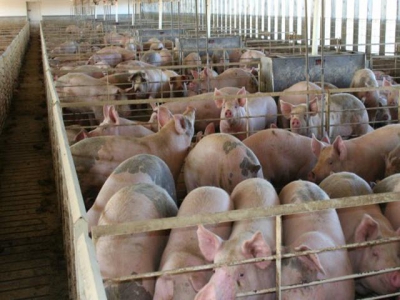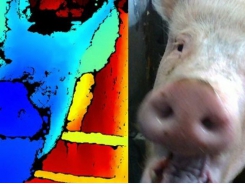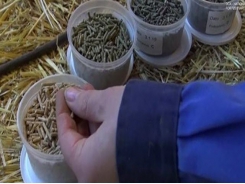African swine fever only part of recent hog rally

Seasonal demand, low price points and new packing plant all part of equation.
Hog prices and product pricing have been much higher than what was previously expected for this time frame, but the levels are not sustainable in the short term, Adam Speck, commodity market analyst for IEG Vantage, told Feedstuffs this week.
The cash hog market has risen from $51.98/cwt. on March 1 to $68.49 on March 27, an unprecedented gain and really an “overbought scenario,” Speck said.
May lean hog futures rose from $65.925/cwt. on March 1 to $86.675/cwt. on March 27. “It seems very aggressive from where we were literally three weeks ago,” he said.
So, what took place? While some reports have attributed the support to African swine fever (ASF) in China, Speck outlined several other reasons for the lift in prices.
First, he said the new Prestage Foods of Iowa pork processing plant came on line during the first part of March. While the ramp-up may not be to the degree the company had hoped, he said it is changing some of the competition for hogs in the short term.
The plant was originally planned to open last fall, and hogs were ready then to supply it. As such, hogs had to be diverted to the open market during the start of the first quarter, but the demand during this March ramp-up required getting the hogs back, Speck explained. This is creating a bit of competition for hogs, especially in the region.
Second, and during the exact same time frame, Speck said there was an “almost perfect storm” for hog prices and futures prices.
He explained that the first full week of March is really when the seasonal shift starts to become official, or at least apparent. There is a 30- to 60-day last-chance window for purchasing product for summer months. Additionally, some prices descended in late February going into the March buying season.
The price point has also been fantastic compared to the prior year, Speck said.
“Depending on the specific primal, you’re talking about a 20-25% price differential under this exact same time last year. It was beating budgets by a landslide,” he said.
The seasonal turn in demand, the packing facility opening and wanting hogs, a price point that met or exceeded budgets and a limited buying window to prepare for summer grilling season all provided a “fantastic scenario” where further downside risk had almost been eliminated, Speck said.
The historically low pricing structure, he said, is because fewer exports are going to China and Mexico due to ongoing trade negotiations.
“So, the perfect storm for the directional shift could not be any better,” he said.
In addition to all of these circumstances, the market is also still seeing upside potential from the fears of ASF in China.
Furthermore, even though China and Mexico are still not back normal trade levels, Speck said there is confidence in the market that they will be back.
Mexico will likely return during the second half of 2019, he said, adding that China, on the other hand, is a “political drama.” With ASF, however, the futures market is betting that China will be back sooner rather than later, with orders beginning to appear.
The worst of tough times should be over, at least through the summer, Speck said.
Yes, another downcycle is still expected in the late summer and early fall, “but right now, the price forecast looks to be very, very strong for the summer months.”
Rumored buys from China
There have been recent rumors that China plans to purchase U.S. pork, but Speck said IEG believes those buys do not match up with two things: how China consumes pork, and how China stores pork.
“They don’t consume pork seasonally strong like we do in our summer grilling months. China’s months for consuming pork is the December, January and February time frame,” Speck said.
As such, China's seasonal demand for product is November through February, when they are preparing for the Chinese New Year. China “buying pork right now doesn’t jive,” he said. “You don’t put product away today unless you’re going to use it six months from today. Why are they going to pull it out in August or September? That’s not pork month for China.”
The only the reason they may pull it out in that time frame would be if the ASF situation worsens, Speck said, adding, “If they’re buying, it would be for cold storage rotations.”
With a 62% tariff on U.S. pork, it doesn’t warrant a slow boat to China and then a cold storage rotation for the next six months, he noted, at least not yet.
Also, when looking at the price structure for pork in China, it is still more favorable to buy domestic pork, Speck said.
“These rumors of buys, I don’t know if they will materialize. China has been known to cancel deals in the past,” he said.
Still, Speck said it’s possible that Chinese buyers may be putting in an order so that if the tariffs are removed, they’ll get it at a good price.
As for the impact of ASF in China, Speck said estimates are for anywhere from 5% to 30% losses of the herd. IEG does not expect it to be 30% but closer to 5-7% and maybe a 7-12% loss as the third quarter rolls around.
Speck also pointed out that ASF is killing consumer demand for pork in China, with many switching to poultry. Poultry production in China is expected to increase by 8% this year, but Speck said it could be up to 12-15% higher if the ASF situation worsens.
“You can expand your broiler flock much, much quicker than you can expand your swine herd. I believe those numbers could be realized,” he said.
Related news
Tools

Phối trộn thức ăn chăn nuôi

Pha dung dịch thủy canh

Định mức cho tôm ăn

Phối trộn phân bón NPK

Xác định tỷ lệ tôm sống

Chuyển đổi đơn vị phân bón

Xác định công suất sục khí

Chuyển đổi đơn vị tôm

Tính diện tích nhà kính

Tính thể tích ao



 Loss-of-function mutations cause embryonic lethality in pigs
Loss-of-function mutations cause embryonic lethality in pigs  Chinese researchers isolate African swine fever virus
Chinese researchers isolate African swine fever virus